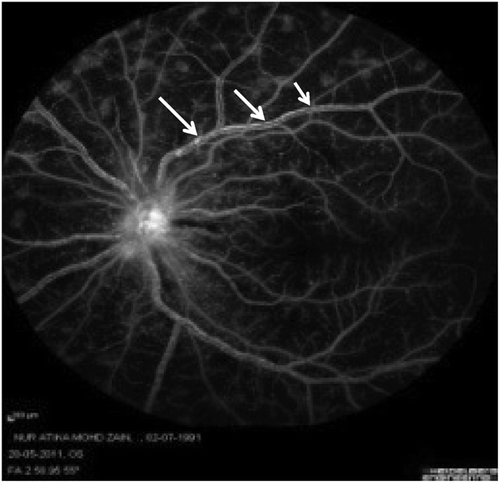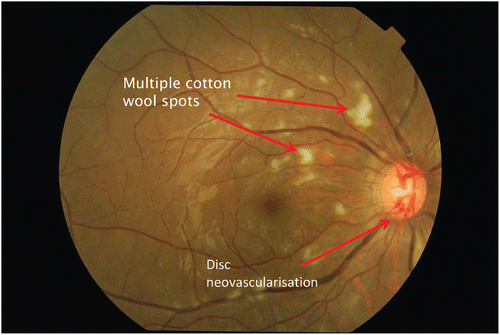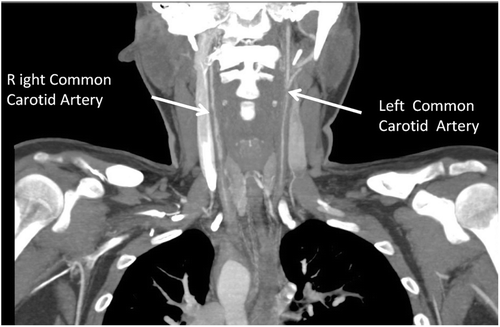Abstract
Purpose: To report a young woman who presented with blindness secondary to ocular ischemic syndrome (OIS) as the initial presenting feature of Takayasu arteritis (TA).
Design: Case report. Methods: Computer tomography (CT) aortogram showed severely stenosed aortic branches. Fundus fluorescein angiography showed diffuse capillary nonperfusion.
Results: With conventional medical therapy of initial pulse of intravenous methylprednisolone followed by oral steroids and methotrexate, her headache, fatigued feeling, and inflammatory markers improved. However, the visual recovery remained poor.
Conclusions: OIS in TA may present subacutely and the visual outcome can be poor despite aggressive immunosuppressive therapy.
KEYWORDS::
CASE REPORT
A 20-year-old woman with no known medical illness, presented to our center with fatigue, headache, and progressive decline in bilateral visual acuity over a period of 3 weeks. She did not experience any other symptoms, such as arthralgia, angina, dyspnoea, or limb claudication. The visual acuity was hand motions on the left and light perception on the right. On examination of the anterior segments, there was corneal edema without iris or angle neovascularization and the lenses were clear. The posterior segments bilaterally showed neovascularization at the disc, multiple cotton wool spots, and microaneurysm temporally (). Fundus fluorescein angiography showed diffuse and extensive areas of capillary nonperfusion (). Based on the above findings, an ocular diagnosis of bilateral ocular ischemic syndrome (OIS) was made. Systemic examination revealed absent peripheral pulses with left carotid bruit. Her heart sounds were normal with no murmur.
FIGURE 2 Fundus fluorescein angiography showing diffuse and extensive areas of capillary nonperfusion.

Erythrocyte sedimentation rate was markedly elevated, i.e, 84 mm/h. A brain MRI was normal, whereas a CT aortogram showed severely stenosed right brachiocephalic trunk, left common carotid artery, and left vertebral artery with mural thrombus at the arch of the aorta (, ). Based on an age at disease onset of less than 40 years, decreased brachial artery pressure, systolic blood pressure difference of more than 10 mmHg between the limbs, and radiographic findings, she fulfilled the 1990 American College of Rheumatology diagnostic criteria for Takayasu arteritis (TA).Citation1 The radiographic involvement of the aortic arch and its branches were in keeping with type 1 TA.
FIGURE 3 CT aortogram showing severely stenosed right brachiocephalic trunk, left common carotid artery, and left vertebral artery.

She was treated with intravenous pulse of methylprednisolone 1 g daily for 3 days, followed by oral prednisolone at 1 mg/kg/day and weekly oral methotrexate of 15 mg. She was anticoagulated with oral warfarin for the mural thrombus at the aortic arch. The patient had panretinal photocoagulation for the optic disc neovascularization. On day 3 of admission, there was slight improvement in her vision to finger counting bilaterally. The patient requested to defer carotid angioplasty. During follow-up after 1 month, her visual acuity remained the same.
DISCUSSION
TA or the “pulseless disease”—characterized by inflammatory narrowing of arteries arising from the aortic arch—may rarely cause OIS due to involvement of the ophthalmic artery.Citation2 To the best of our knowledge, this is the fifth case report of OIS as the initial manifestation of TA. This case highlights that TA is an important differential diagnosis to consider in cases of progressive loss of vision in young patients.
The other learning point from this case is the guarded visual prognosis with medical therapy alone in this setting. Medical treatment suppresses inflammation and prevents further vascular damage but may not be adequate to restore perfusion in critical vascular stenosis. The patient’s refusal of surgical intervention was a major drawback given the data of high rates of success in TA with both bypass surgeries and angioplasty.Citation3,Citation4
Biologic agents such as tumor necrosis factor antagonists, in recent years have emerged as first-line therapy in severe forms of rheumatic diseases. In TA, however, these agents have only been tried in refractory cases and, hence, were not considered in this patient due to the lack of strong supporting evidence.Citation5
In conclusion, OIS in TA may present subacutely and the visual outcome can be poor despite aggressive immunosuppressive therapy.
Declaration of interest: The authors report no conflicts of interest. The authors alone are responsible for the content and writing of the paper.
REFERENCES
- Arend WP, Michel BA, Bloch DA, et al. The American College of Rheumatology 1990 criteria for the classification of Takayasu arteritis. Arthritis Rheum. [Research Support, U.S. Gov’t, P.H.S.]. 1990 Aug;33 (8):1129–1134.
- Koz OG, Ates A, Numan Alp M, Gultan E, Karaaslan Y, Kural G. Bilateral ocular ischemic syndrome as an initial manifestation of Takayasu’s arteritis associated with carotid steal syndrome. Rheumatol Int. 2007;27 (3):299–302.
- Narins CR, Illig KA. Patient selection for carotid stenting versus endarterectomy: a systematic review. J Vasc Surg. 2006;44 (3):661–672.
- Cong XL, Dai SM, Feng X, et al. Takayasu’s arteritis: clinical features and outcomes of 125 patients in China. Clin Rheumatol. 2010;29 (9):973–981.
- Maffei S, Di Renzo M, Santoro S, Puccetti L, Pasqui AL. Refractory Takayasu arteritis successfully treated with infliximab. Eur Rev Med Pharmacol Sci. 2009;13 (1):63–65.

